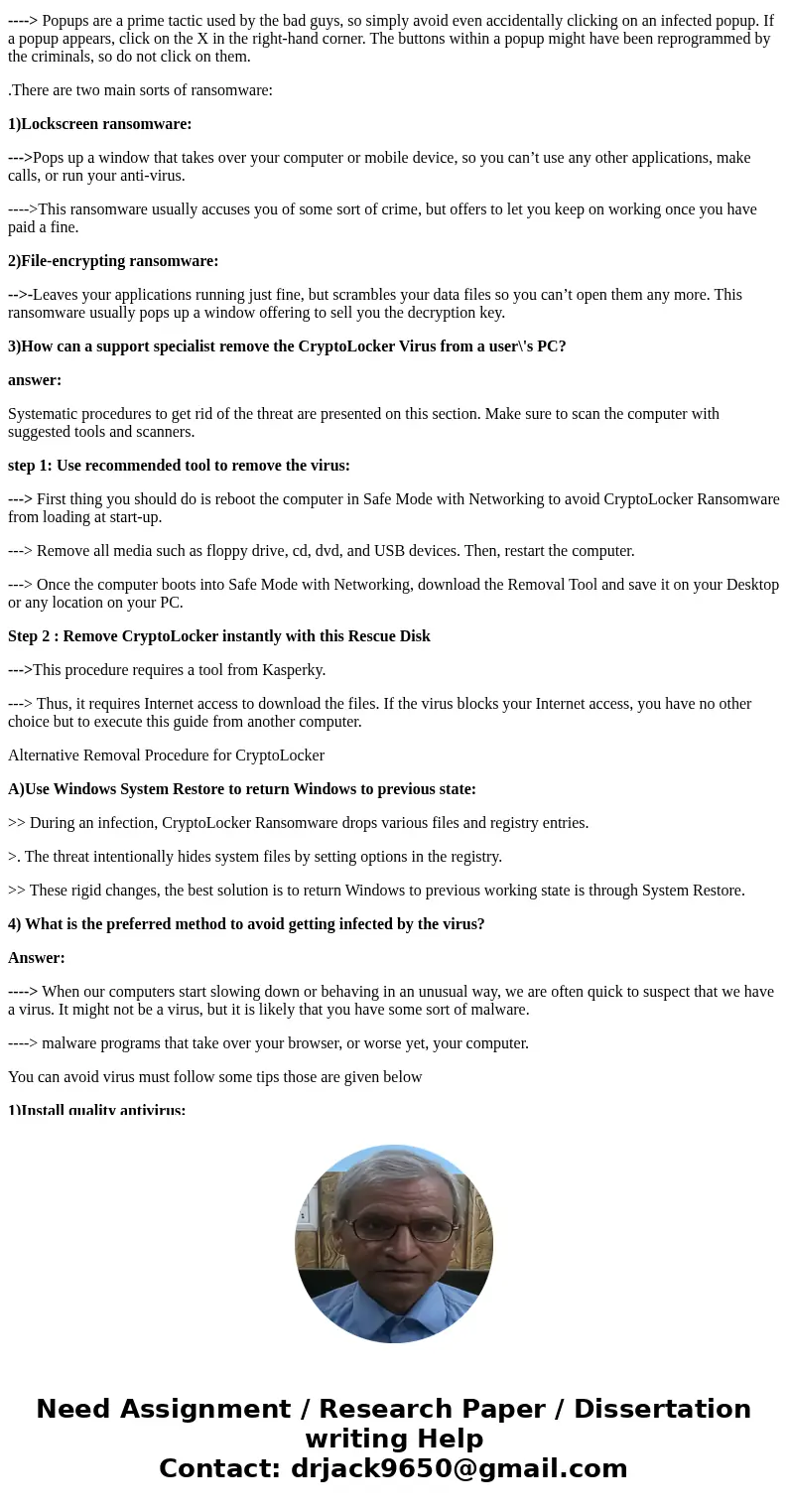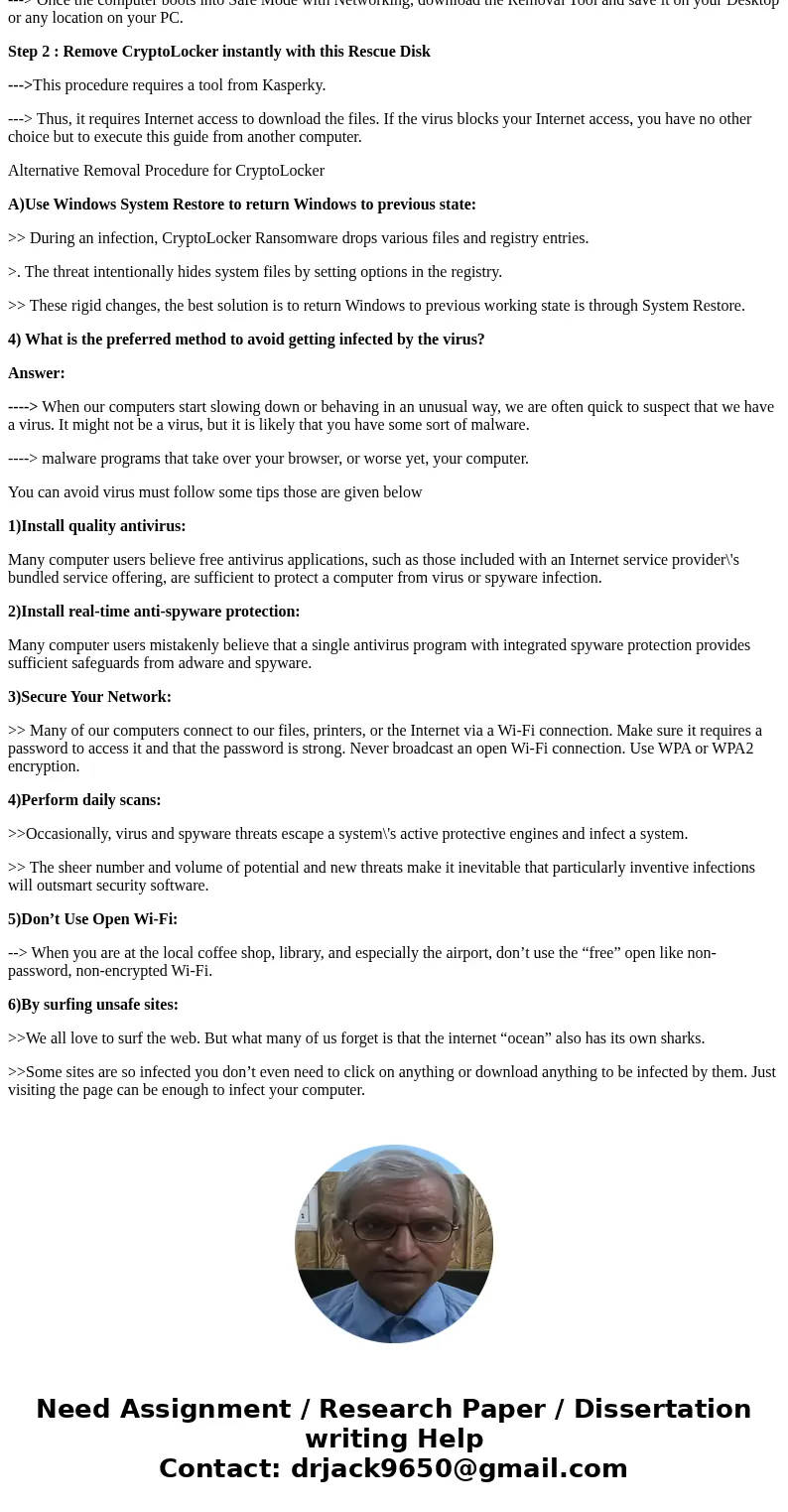Write a description of CryptoLocker Virus 1 paragraph for f
Write a description of CryptoLocker Virus, + 1 paragraph for first 2 questions, + 1 paragraph for last 2 questions Research a security threat.
I want a paragraph for each the first 2 questons and the last 2 questions
1- What are the symptoms that a PC has been infected by the CryptoLocker Virus?
2- What advice would you give users about whether to pay the ransom demanded?
3 - How can a support specialist remove the CryptoLocker Virus from a user\'s PC?
4- What is the preferred method to avoid getting infected by the virus?
Solution
CryptoLocker Virus:
>> CryptoLocker is a new family of ransomware whose business model (yes, malware is a business to some!) is based on extorting money from users.
>> This continues the trend started by another infamous piece of malware which also extorts its victims, the so- called ‘Police Virus’.
>> However, unlike the Police Virus, CryptoLocker hijacks users’ documents and asks them to pay a ransom.
>> CryptoLocker propagated via infected email attachments, and via an existing botnet; when activated, the malware encrypts certain types of files stored on local and mounted network drives using RSA public-key.
>> The private key stored only on the malware\'s control servers.
>>The CryptoLocker itself is readily removed, files remained encrypted in a way which researchers considered unfeasible to break.
.
1)What are the symptoms that a PC has been infected by the CryptoLocker Virus?
CryptoLocker is a ransomware program that was released in the beginning of September 2013 that targets all versions of Windows including Windows XP, Windows Vista, Windows 7, and Windows 8.The CryptoLocker Trojan is a ransomware infection that encrypts the victim\'s files. CryptoLocker may typically be installed by another threat such as a Trojan downloader or a worm.CryptoLocker uses social engineering techniques to trick the user into running it. More specifically, the victim receives an email with a password-protected ZIP file purporting to be from a logistics company.
----> CryptoLocker different than most older ransomware malware is the use of asymmetric key cryptography.
----> CryptoLocker reveals itself only after it has scrambled your files, which it does only if it is online and has already identified you and your computer to the encryption server run by the criminals.
2) What advice would you give users about whether to pay the ransom demanded?
Ransomware is a type of malware that is delivered through your computer system through infected email attachments, drive-by-downloads, socially engineered malware, malvertising, or unknowingly via hacked websites
--> Once on your system, ransomware gets to work and starts encrypting and locking down your files.
----> As with other attacks, you can work to avoid ransomware. Experts advise taking these steps to avoid attacks or protect yourself after an attack.
a)Use reputable antivirus software and a firewall:
---> Maintaining a strong firewall and keeping your security software up to date are critical. It’s important to use antivirus software from a reputable company because of all the fake software out there.
b)Enable your popup blocker:
----> Popups are a prime tactic used by the bad guys, so simply avoid even accidentally clicking on an infected popup. If a popup appears, click on the X in the right-hand corner. The buttons within a popup might have been reprogrammed by the criminals, so do not click on them.
.There are two main sorts of ransomware:
1)Lockscreen ransomware:
--->Pops up a window that takes over your computer or mobile device, so you can’t use any other applications, make calls, or run your anti-virus.
---->This ransomware usually accuses you of some sort of crime, but offers to let you keep on working once you have paid a fine.
2)File-encrypting ransomware:
-->-Leaves your applications running just fine, but scrambles your data files so you can’t open them any more. This ransomware usually pops up a window offering to sell you the decryption key.
3)How can a support specialist remove the CryptoLocker Virus from a user\'s PC?
answer:
Systematic procedures to get rid of the threat are presented on this section. Make sure to scan the computer with suggested tools and scanners.
step 1: Use recommended tool to remove the virus:
---> First thing you should do is reboot the computer in Safe Mode with Networking to avoid CryptoLocker Ransomware from loading at start-up.
---> Remove all media such as floppy drive, cd, dvd, and USB devices. Then, restart the computer.
---> Once the computer boots into Safe Mode with Networking, download the Removal Tool and save it on your Desktop or any location on your PC.
Step 2 : Remove CryptoLocker instantly with this Rescue Disk
--->This procedure requires a tool from Kasperky.
---> Thus, it requires Internet access to download the files. If the virus blocks your Internet access, you have no other choice but to execute this guide from another computer.
Alternative Removal Procedure for CryptoLocker
A)Use Windows System Restore to return Windows to previous state:
>> During an infection, CryptoLocker Ransomware drops various files and registry entries.
>. The threat intentionally hides system files by setting options in the registry.
>> These rigid changes, the best solution is to return Windows to previous working state is through System Restore.
4) What is the preferred method to avoid getting infected by the virus?
Answer:
----> When our computers start slowing down or behaving in an unusual way, we are often quick to suspect that we have a virus. It might not be a virus, but it is likely that you have some sort of malware.
----> malware programs that take over your browser, or worse yet, your computer.
You can avoid virus must follow some tips those are given below
1)Install quality antivirus:
Many computer users believe free antivirus applications, such as those included with an Internet service provider\'s bundled service offering, are sufficient to protect a computer from virus or spyware infection.
2)Install real-time anti-spyware protection:
Many computer users mistakenly believe that a single antivirus program with integrated spyware protection provides sufficient safeguards from adware and spyware.
3)Secure Your Network:
>> Many of our computers connect to our files, printers, or the Internet via a Wi-Fi connection. Make sure it requires a password to access it and that the password is strong. Never broadcast an open Wi-Fi connection. Use WPA or WPA2 encryption.
4)Perform daily scans:
>>Occasionally, virus and spyware threats escape a system\'s active protective engines and infect a system.
>> The sheer number and volume of potential and new threats make it inevitable that particularly inventive infections will outsmart security software.
5)Don’t Use Open Wi-Fi:
--> When you are at the local coffee shop, library, and especially the airport, don’t use the “free” open like non-password, non-encrypted Wi-Fi.
6)By surfing unsafe sites:
>>We all love to surf the web. But what many of us forget is that the internet “ocean” also has its own sharks.
>>Some sites are so infected you don’t even need to click on anything or download anything to be infected by them. Just visiting the page can be enough to infect your computer.



 Homework Sourse
Homework Sourse